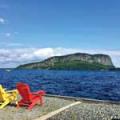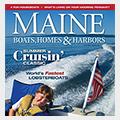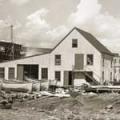Letters to the Editor - Issue 134
Issue 134
Tidal energy back in the news
The article “FDR’s Beloved Island” (Winter 2015) was well done with excellent photographs. It noted that Franklin Roosevelt spent every summer on Campobello in his youth and knew all about the 24-foot tides. We know he must also have been aware of the poverty in Eastport and Lubec. Not mentioned was how he tried to improve the economy of Eastport, Washington County, and the whole state of Maine. It was 1935 and Franklin wanted to pull the whole country out of the Depression. One proposed project was the “Quoddy Dam Project,” designed to take advantage of those 24-foot tides by capturing the incoming tide behind dams and slowly releasing the water to generate electricity.
The idea was first conceived by Campobello resident and engineer Dexter Cooper in 1919. He sold the idea to Westinghouse and General Electric. After the stock market crash of 1929, the government was asked to take over. FDR championed it, and, in 1934, along with the Boulder Dam, it became a WPA project under the Army Corps of Engineers. Cost estimates were $35 million. Work began in 1935 with the Corps spending several million on housing at Quoddy as they considered Eastport unable to handle the thousands of workers required to build the dams.
There was great excitement in Washington County. Several million dollars later, alas, the newspapers got ahold of the story, and by 1936 had convinced FDR that it simply was not feasible to generate power from the tides. The project was canceled. What did the country and Maine lose? Well, lots of electricity, a huge aluminum factory, and a possible Navy base for WWII.
Fast forward to 2014: There are new plans on the board to capture the tides at the town of Pembroke. Stay tuned.
Bill Ambrose
North Yarmouth, ME
Seeing seaweed
Carl Little’s article about me in the Winter 2015 issue is brilliant. It amazes me how he was able to integrate all of the disparate connections into a seemingly effortless network that just made it all appear to be evident and inevitable. (Of course it is a seaweed boat. Isn’t that perfectly natural!)
I am continuing my collaboration with Jessica Muhlin on her rockweed research at Beals Island and Schoodic. Fascinating. I have learned to distinguish male from female rockweed (Fucus vesiculosis), and we are hoping to come up with some kind of public art proposal within a year or two. We are both applying for grants to continue our collaboration. I gave a presentation at the Schoodic Institute on art/science collaboration in late September at their first symposium on the topic. I leave for Hawaii soon to visit volcanoes and seaweed beds on the Big Island. There is so much to do and so little time.
Celeste Roberge
South Portland, ME
More on lettercutting, please
I enjoy MBH&H very much, but in the article “Lettercutters: Father & Daughter Chisel Meaning Into Stone” (Winter 2015), I feel that additional details would have greatly enhanced the article, as well as made it more informative and interesting to your readers. Specifically, although the author says that a brass mallet is used and you see a partial picture of one of the chisels, are these steel, and if so, what hardness, and are they conventional cold chisels? And although the author cites the length of time it takes to carve letters, is part of this re-sharpening the tools? Refining the edges, or points? And what kind of toll does this constant hammering and dust take on the creator?
It is my understanding that many early stonecutters died from inhaling stone dust, but no mention or pictures are shown of any safeguards being used or taken.
Included here is a photo of Perch on her mooring in Center Harbor.
A. E. Waterhouse
Freeport, ME & Pace, FL
Lettercutter Douglas Coffin replies:
“Sigrid and I use 1-lb. brass mallets for slate and smaller letters in marble. We use steel mallets (2- and 3-lb.) for granite and larger letters. Our lettering chisels, which come from England, are made of steel with carbide implanted tips that last a long time and need only occasional sharpening, more when working in granite. We use an air hammer, if practical, to remove large amounts of stone, although we’ll finish off the letters by hand. Finally, carving by hand results in more chips than dust. From time to time we need to address harder stones with air hammers or grinders, and then we always wear masks.”
Cheers from the Androids
You’ve finally seen the light and have included us lowlife Android owners in your digital edition. I really enjoyed the March issue in print and found the online version easy to navigate as well. I’m not sure about the sound effects when turning the pages, but I’m sure you can tell me how to fix it.
Thank you,
Steve Bunnell
Camden, ME and
Marstons Mills, MA
Gentle readers:
In the upper right under “settings,” uncheck “flip sound” and silence will reign. —The Editors
Timing is everything
The latest issue of Maine Boats, Homes & Harbors comes in the door, then there’s another big storm. What can we do but curl up and read? We heart MBH&H.
Janet Strong
Mt. Desert, ME
Cheeky humor
Many years ago I read a well-written poem in your magazine about a person who claimed to have been “mooned” by a lobsterman in the Deer Isle Thorofare. I wrote the following in response, with no malintent whatsoever. Please take it in the manner of jest in which it was written!
We have the island to ourselves nine months out of the year, men brave the weather fierce or foul to fish their lobster gear.
Traps and lives are sometimes lost to a winter’s gale or blow, life is tough here even harsh, but we love it even so.
Then spring rolls around, things ease up, maybe breathe a sigh of relief, but it’s not to be for hoards of tourists bring 90 days of grief!
They descend in planes, in cars, on bikes, in motor homes, and megayachts, they plug the stores, they fill the streets and run over our lobster pots!
We try to be civil, we try to be sweet, but when Labor Day does come... I and a few others are not disappointed to see the sailors pack up and run.
So if you should sail near Deer Isle and you witness an act with no class, Just turn the other cheek, and try to take it in stride if you should see a fisherman’s…!
Pete Buxton
Stonington, ME
Via the e-mail transom
This non-sailor (fairweather passenger only) loved the print version of the Winter 2015 issue and read it cover to cover!
Mary Ellen Mackin
















